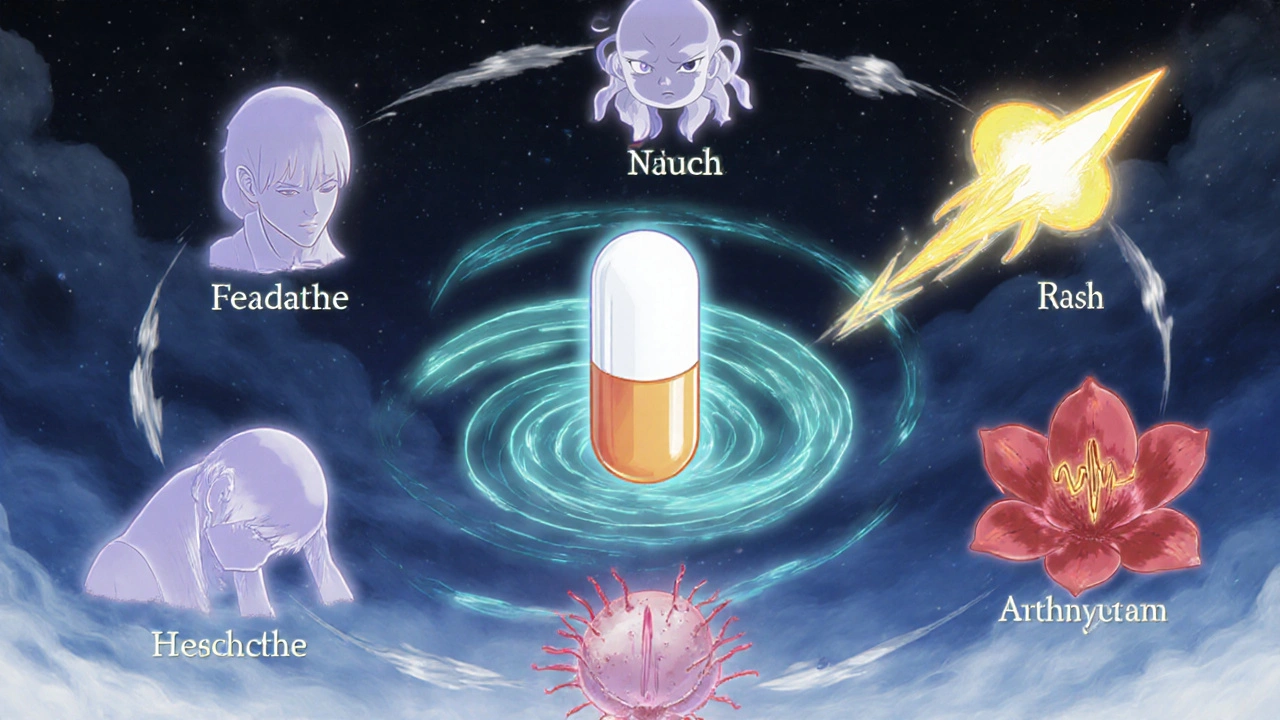When you hear the name Ledipasvir is a direct‑acting antiviral that blocks the NS5A protein of hepatitis C virus (HCV), the first question is usually - how safe is it? Ledipasvir safety matters to anyone starting the once‑daily regimen, especially because the drug is usually paired with Sofosbuvir (the combination sold as Harvoni). This guide walks you through the most recent data, real‑world experiences, and what clinicians watch for when prescribing the therapy.
Quick Takeaways
- Ledipasvir’s most common side‑effects are mild - fatigue, headache, and nausea.
- Serious events (< 1% of patients) include severe rash, liver enzyme spikes, and rare cardiac issues.
- Pregnant women, children under 12, and patients with severe renal impairment were excluded from the pivotal trials, so extra caution is needed.
- Drug‑drug interactions mainly involve P‑glycoprotein (P‑gp) and CYP3A4 substrates; dose adjustments are rare.
- Overall, the safety profile is comparable to other NS5A inhibitors and better than older interferon‑based regimens.
What Is Ledipasvir?
Ledipasvir belongs to the NS5A inhibitor class. It locks onto a viral protein needed for HCV replication, preventing the virus from assembling new particles. Approved by the U.S. Food and Drug Administration (FDA) in 2014, it’s indicated for genotype 1, 4, 5, and 6 infections when used with Sofosbuvir.
How the Pivotal Trials Assessed Safety
The three ION studies (ION‑1, ION‑2, and ION‑3) enrolled over 1,400 patients and are the primary source of safety data. In ION‑3, a 12‑week regimen was tested against a shorter 8‑week arm, showing no new safety signals with the reduced duration. Across all trials, the overall discontinuation rate due to adverse events was under 2%.
Most Frequently Reported Adverse Events
These side‑effects appear in >10% of participants but rarely require stopping therapy:
- Fatigue (12‑15%)
- Headache (10‑13%)
- Nausea or loss of appetite (9‑11%)
- Insomnia (8‑10%)
Most patients notice these symptoms early on and they tend to wane by week four.

Rare but Serious Risks
Serious adverse events (SAEs) were reported in about 0.7% of the pooled ION population. They include:
- Severe rash or Stevens‑Johnson‑like reactions - <1%.
- Elevated liver enzymes (ALT/AST >5× ULN) - 0.3%.
- Cardiac arrhythmias, especially in patients with baseline QT prolongation - isolated cases.
Any SAE prompts immediate evaluation and often a switch to an alternative regimen.
Safety in Special Populations
- Pregnancy & breastfeeding: No controlled studies exist. Animal data show no teratogenicity, but clinicians typically avoid prescribing during pregnancy unless benefits outweigh risks.
- Children & adolescents: Ledipasvir‑Sofosbuvir is approved for patients ≥12 years or ≥35 kg. For younger children, the pediatric formulation of Sofosbuvir is still under investigation.
- Renal impairment: Ledipasvir is primarily excreted via the fecal route; however, patients with eGFR <30 mL/min/1.73 m² were excluded from trials. Real‑world case series suggest no dose adjustment is needed, but close monitoring is advised.
- Advanced liver disease: Patients with Child‑Pugh B or C cirrhosis can be treated, but watch for hepatic decompensation signs. The drug’s safety in decompensated cirrhosis mirrors that of other direct‑acting antivirals.
Drug‑Drug Interactions (DDIs)
Ledipasvir is a substrate of P‑gp and BCRP transporters and a weak inhibitor of CYP3A4. Significant DDIs are rare, but they include:
- Amiodarone: Co‑administration can cause bradycardia; clinicians often pause amiodarone during the first two weeks.
- St. John’s Wort: Induces P‑gp, lowering Ledipasvir levels - avoid.
- Antacids containing aluminum or magnesium: Must be taken at least 4 hours apart from the medication.
Most other commonly prescribed drugs (statins, antihypertensives, diabetic agents) do not require dose changes.
Side‑by‑Side Safety Comparison - Ledipasvir vs. Other NS5A Inhibitors
| Parameter | Ledipasvir (Harvoni) | Daclatasvir | Velpatasvir (Epclusa) |
|---|---|---|---|
| Common AEs (≥10%) | Fatigue, headache, nausea | Fatigue, headache, insomnia | Fatigue, headache, diarrhea |
| Serious AEs (≤1%) | \nRash, elevated LFTs, arrhythmia | Elevated LFTs, anemia | Decompensated liver disease, severe rash |
| Discontinuation due to AEs | 1.8% | 2.2% | 1.5% |
| Renal dose adjustment needed | No | No | No |
| Pregnancy category | Category C (risk cannot be ruled out) | Category C | Category C |
Practical Checklist for Clinicians and Patients
- Confirm HCV genotype and baseline liver function.
- Review current medications for possible P‑gp or CYP3A4 interactions.
- Ask about pregnancy status or plans for conception.
- Measure eGFR; no dose change needed unless <10 mL/min/1.73 m².
- Educate patients: most side‑effects are mild and resolve within weeks.
- Schedule labs at baseline, week 4, and end‑of‑treatment to catch any liver enzyme spikes.
- If a serious rash or cardiac symptom appears, stop therapy and initiate alternative regimen.
Frequently Asked Questions
Can I take Ledipasvir if I have kidney disease?
Ledipasvir is cleared mainly through the gut, so kidney function doesn’t drastically affect drug levels. Patients with eGFR above 30 mL/min can use the standard dose, but those with severe renal impairment should be monitored closely and discussed with a hepatology specialist.
What should I do if I develop a rash while on treatment?
Mild itching is common and can be managed with antihistamines. A widespread or blistering rash warrants immediate cessation of Ledipasvir‑Sofosbuvir and referral to dermatology. Never restart without medical clearance.
Is it safe to drink alcohol while being treated?
Alcohol doesn’t interact directly with Ledipasvir, but it can worsen liver inflammation. Clinicians usually advise limiting intake, especially in patients with existing fibrosis or cirrhosis.
How long do side‑effects usually last?
Most mild symptoms peak within the first two weeks and fade by week four. Persistent fatigue beyond week eight should be evaluated.
Can Ledipasvir be used after a failed treatment with another DAA?
Yes. Resistance‑associated substitutions (RAS) can affect efficacy, but combining Ledipasvir with Sofosbuvir and a protease inhibitor (e.g., Voxilaprevir) is an approved rescue regimen.
Bottom line: Ledipasvir’s safety record is solid, with mostly mild, self‑limited side‑effects and a low rate of serious complications. By screening for contraindications, watching for rare reactions, and counseling patients about what to expect, clinicians can use the drug confidently to cure hepatitis C in the vast majority of cases.


Ledipasvir appears to be marketed as a miracle cure but the data tells a different story. The safety tables reveal a pattern of under‑reported adverse events. Patients often dismiss fatigue as trivial when it is a sign of metabolic strain. Headaches are catalogued as mild yet they affect daily productivity. Nausea is labelled occasional but for some it persists beyond the first week. The trials excluded the most vulnerable groups and then claim universal safety. Real‑world studies show a higher incidence of rash in African descent populations. Cardiac arrhythmias, though rare, were noted in patients with pre‑existing QT issues. The authors of the ION studies downplay these findings with glossy language. A toxic analyst would point out the selective reporting bias. The sponsor’s financial interests are obvious in the glossy press releases. Clinicians should demand transparency rather than rely on glossy abstracts. The drug‑drug interaction section is thin and ignores many common antibiotics. P‑gp inhibitors can raise plasma levels and the paper barely mentions it. The safety profile is not comparable to older interferon regimens when you factor in quality of life. In short the headline safety claim is overstated and patients deserve a fuller picture.
The safety data holds up for typical adults, yet it completely sidesteps high‑risk groups.
Oh sure, let’s all trust the glossy safety brochure because the sponsors said so. It’s comforting to think a pill can cure a virus without any baggage, isn’t it? Yet the real world rarely conforms to trial cherry‑picking. When you look at the exclusion criteria you see pregnant women, kids, and those with kidney failure left out like unwanted guests. The moral of the story is that we are being spoon‑fed a narrative that serves pharma profits. If you care about patient autonomy you’ll question a regimen that hides serious rash under the rug. The cardiac warnings are buried in fine print, effectively invisible to most prescribers. One could argue that a drug that requires such caveats is anything but harmless. I find it disconcerting that a drug that requires such caveats is anything but harmless. The ethical line blurs when safety is presented as a selling point rather than an open discussion. Ultimately, the onus is on us to demand transparency, not accept complacency.
I totally get why you feel that way, it can be realy frustrating when data feels hidden : ) many patients just want clear info and i think we should push for more open studies.
For clinicians seeking a comprehensive overview, the ION trial data can be accessed through the FDA’s electronic submissions, which include detailed adverse event tables. It is advisable to review the subset analyses for patients with baseline QT prolongation, as well as the pharmacokinetic interactions with common P‑gp inhibitors such as amiodarone. Moreover, counseling patients on the expected timeline of fatigue and headache-typically resolving by week four-can improve adherence. In pregnant or lactating patients, a multidisciplinary discussion with obstetrics is recommended, given the lack of controlled data. Overall, the safety profile remains favorable when used in accordance with the label, but vigilance for rash and hepatic enzyme elevations is essential. Should any serious adverse event arise, a prompt switch to an alternative DAA regimen is prudent.
It is incumbent upon the medical community to not merely acknowledge these guidelines but to actively implement rigorous monitoring protocols; failure to do so would constitute a dereliction of our professional duty. The data unequivocally demonstrate that early detection of hepatic transaminase spikes can prevent irreversible liver injury, and therefore routine laboratory assessment at weeks two and six is non‑negotiable. Furthermore, the clinician must assertively educate patients on the improbability of severe cardiac events while simultaneously remaining prepared to intervene at the first sign of arrhythmia. In the grand tapestry of hepatitis C eradication, adherence to these safety measures is the keystone that upholds therapeutic success. I implore all prescribers to integrate these practices without hesitation, for the stakes are nothing short of life‑saving.
America leads the world in drug innovation, and Harvoni is a prime example of that excellence 🇺🇸💪. Anything that questions its safety is just anti‑American propaganda, and we shouldn’t let skeptics tarnish a product that has saved countless lives.
Indeed, the results speak for themselves.